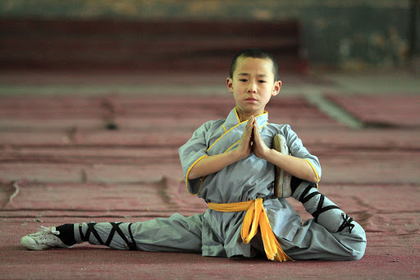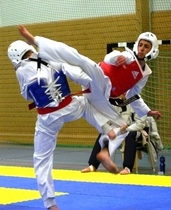
Taekwondo
Taekwondo, Tae Kwon Do or Taekwon-Do (Korean 태권도/跆拳道 ) is a Korean martial art, characterized by its emphasis on head-height kicks, jumping and spinning kicks, and fast kicking techniques. Taekwondo is a combative sport and was developed during the 1940s and 1950s by Korean martial artists with experience in martial arts such as karate, Chinese martial arts, and indigenous Korean martial arts traditions such as Taekkyon, Subak, and Gwonbeop. The oldest governing body for Taekwondo is the Korea Taekwondo Association (KTA), formed in 1959 through a collaborative effort by representatives from the nine original kwans, or martial arts schools, in Korea. The main international organisational bodies for Taekwondo today are the International Taekwon-Do Federation (ITF), founded by Choi Hong Hi in 1966, and the partnership of the Kukkiwon and World Taekwondo (WT, formerly WTF), founded in 1972 and 1973 respectively by the Korea Taekwondo Association. Gyeorugi , a type of full-contact sparring, has been an Olympic event since 2000. The governing body for Taekwondo in the Olympics and Paralympics is World Taekwondo.
See all
0
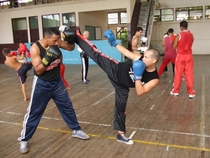
Savate
Savate , also known as boxe française, savate boxing, French boxing or French footfighting, is a French combat sport that uses the hands and feet as weapons combining elements of English boxing with graceful kicking techniques. Only foot kicks are allowed, unlike some systems such as Muay Thai, which allow the use of the knees or shins. Savate is a French word for "old shoe or boot". Savate fighters wear specially designed boots. A male practitioner of savate is called a tireur while a female is called a tireuse.
See all
0
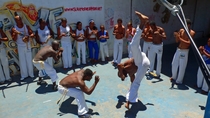
Capoeira
Capoeira is an Afro-Brazilian martial art that combines elements of dance, acrobatics, and music. It was developed by enslaved Africans in Brazil at the beginning of the 16th century. It is known for its acrobatic and complex maneuvers, often involving hands on the ground and inverted kicks. It emphasizes flowing movements rather than fixed stances; the ginga, a rocking step, is usually the focal point of the technique. The most widely accepted origin of the word capoeira comes from the Tupi words ka'a ("forest") paũ ("round"), referring to the areas of low vegetation in the Brazilian interior where fugitive slaves would hide. A practitioner of the art is called a capoeirista . On 26 November 2014, capoeira was granted a special protected status as intangible cultural heritage by UNESCO.
See all
0
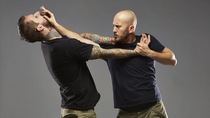
Krav Maga
Krav Maga (lit. "contact combat") is a military self-defence and fighting system developed for the Israel Defense Forces (IDF) and Israeli security forces derived from a combination of techniques sourced from boxing, wrestling, aikido, judo, and karate along with realistic fight training. Krav Maga is known for its focus on real-world situations and its extreme efficiency. It was derived from the street-fighting experience of Hungarian-Israeli martial artist Imi Lichtenfeld, who made use of his training as a boxer and wrestler, while defending the Jewish quarter against fascist groups in Bratislava, Czechoslovakia, during the mid-to-late 1930s. In the late 1940s, following his migration to Israel, he began to provide lessons on combat training to what was to become the IDF. From the outset, the original concept of Krav Maga was to take the most simple and practical techniques of other fighting styles (originally European boxing, wrestling, and street fighting) and to make them rapidly teachable to military conscripts. Krav Maga has a philosophy emphasizing aggression, and simultaneous defensive and offensive maneuvers. Krav Maga has been used by the Israel Defense Forces' special forces units, security forces and by regular infantry units. Closely related variations have been developed and adopted by Israeli law enforcement and intelligence organizations. There are several organizations teaching variations of Krav Maga internationally.
See all
0
Arnis
Arnis, also known as Kali or Eskrima/Escrima, is the national martial art of the Philippines. The three are roughly interchangeable umbrella terms for the traditional martial arts of the Philippines ("Filipino Martial Arts", or FMA), which emphasize weapon-based fighting with sticks, knives, bladed weapons, and various improvised weapons, as well as "open hand" or techniques without weapons. It is also known as Estoque (Spanish for rapier), Estocada (Spanish for thrust or stab) and Garrote (Spanish for club). In Luzon it may go by the name of Arnis de Mano. The indigenous martial art that the Spanish encountered in 1610 was not yet called "Eskrima" at that time. During those times, this martial art was known as Paccalicali-t (pronounced as pakkali-kalî) to the Ibanags, Didya (later changed to Kabaroan) to the Ilokanos, Sitbatan or Kalirongan to Pangasinenses, Sinawali ("to weave") to the Kapampangans, Calis or Pananandata ("use of weapons") to the Tagalogs, Pagaradman to the Ilonggos and Kaliradman to the Cebuanos. Kuntaw and Silat are separate martial arts that are also practised in the Philippine Archipelago. There have been campaigns for arnis to be nominated in the UNESCO Intangible Cultural Heritage Lists, along with other Philippine martial arts. As of 2018, UNESCO has inscribed 9 martial-arts–related intangible heritage.
See all
0
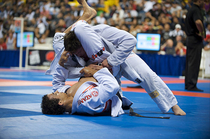
Brazilian jiu-jitsu
Brazilian jiu-jitsu (BJJ; jiu-jitsu brasileiro) is a self-defense system, martial art and combat sport system that focuses on grappling with particular emphasis on ground fighting. Brazilian jiu-jitsu was developed from Kodokan judo ground fighting (newaza) fundamentals that were taught by a number of Japanese individuals including Takeo Yano, Mitsuyo Maeda, Soshihiro Satake, and Isao Okano. Brazilian jiu-jitsu eventually came to be its own defined combat sport through the innovations, practices, and adaptation of judo. BJJ teaches that a smaller, weaker person can successfully defend themself against a bigger, stronger, heavier opponent by using leverage to take the fight to the ground, and then applying joint locks and chokeholds to defeat the opponent. BJJ training can be used for sport grappling tournaments and in self-defense situations.
See all
0
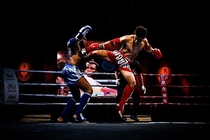
Muay Thai
Muay Thai (มวยไทย, ) or literally Thai boxing is a combat sport of Thailand that uses stand-up striking along with various clinching techniques. This discipline is known as the "art of eight limbs" as it is characterized by the combined use of fists, elbows, knees, and shins. Muay Thai became widespread internationally in the late 20th to 21st century, when westernized practitioners from Thailand began competing in kickboxing, mixed rules matches, as well as matches under Muay Thai rules around the world. The professional league is governed by The Professional Boxing Association of Thailand (P.A.T) sanctioned by The Sports Authority of Thailand (SAT), and World Professional Muaythai Federation (WMF) overseas. It is similar to related styles in other parts of the Indian cultural sphere, namely Lethwei in Myanmar, Pradal Serey in Cambodia, Muay Lao in Laos, and Tomoi in Malaysia.
See all
0
Boxing
Boxing is a combat sport in which two people, usually wearing protective gloves, throw punches at each other for a predetermined amount of time in a boxing ring. Amateur boxing is both an Olympic and Commonwealth Games sport and is a standard fixture in most international games—it also has its own World Championships. Boxing is overseen by a referee over a series of one- to three-minute intervals called rounds. A winner can be resolved before the completion of the rounds when a referee deems an opponent incapable of continuing, disqualification of an opponent, or resignation of an opponent. When the fight reaches the end of its final round with both opponents still standing, the judges' scorecards determine the victor. In the event that both fighters gain equal scores from the judges, professional bouts are considered a draw. In Olympic boxing, because a winner must be declared, judges award the contest to one fighter on technical criteria. While humans have fought in hand-to-hand combat since the dawn of human history, the earliest evidence of fist-fighting sporting contests date back to the ancient Near East in the 3rd and 2nd millennia BC. The earliest evidence of boxing rules date back to Ancient Greece, where boxing was established as an Olympic game in 688 BC. Boxing evolved from 16th- and 18th-century prizefights, largely in Great Britain, to the forerunner of modern boxing in the mid-19th century with the 1867 introduction of the Marquess of Queensberry Rules.
See all
0

